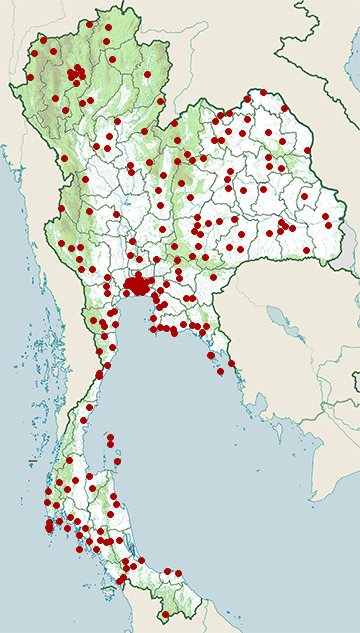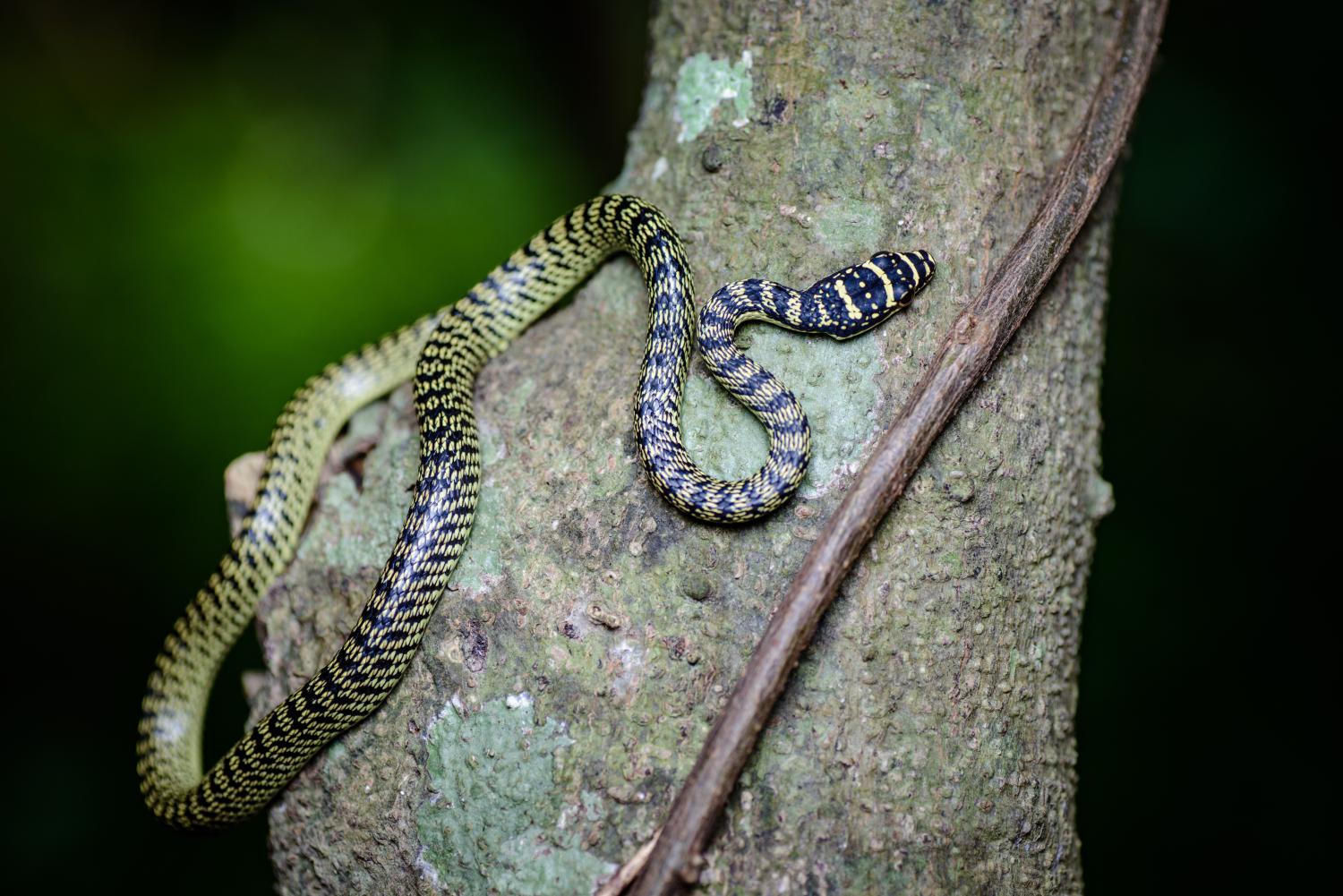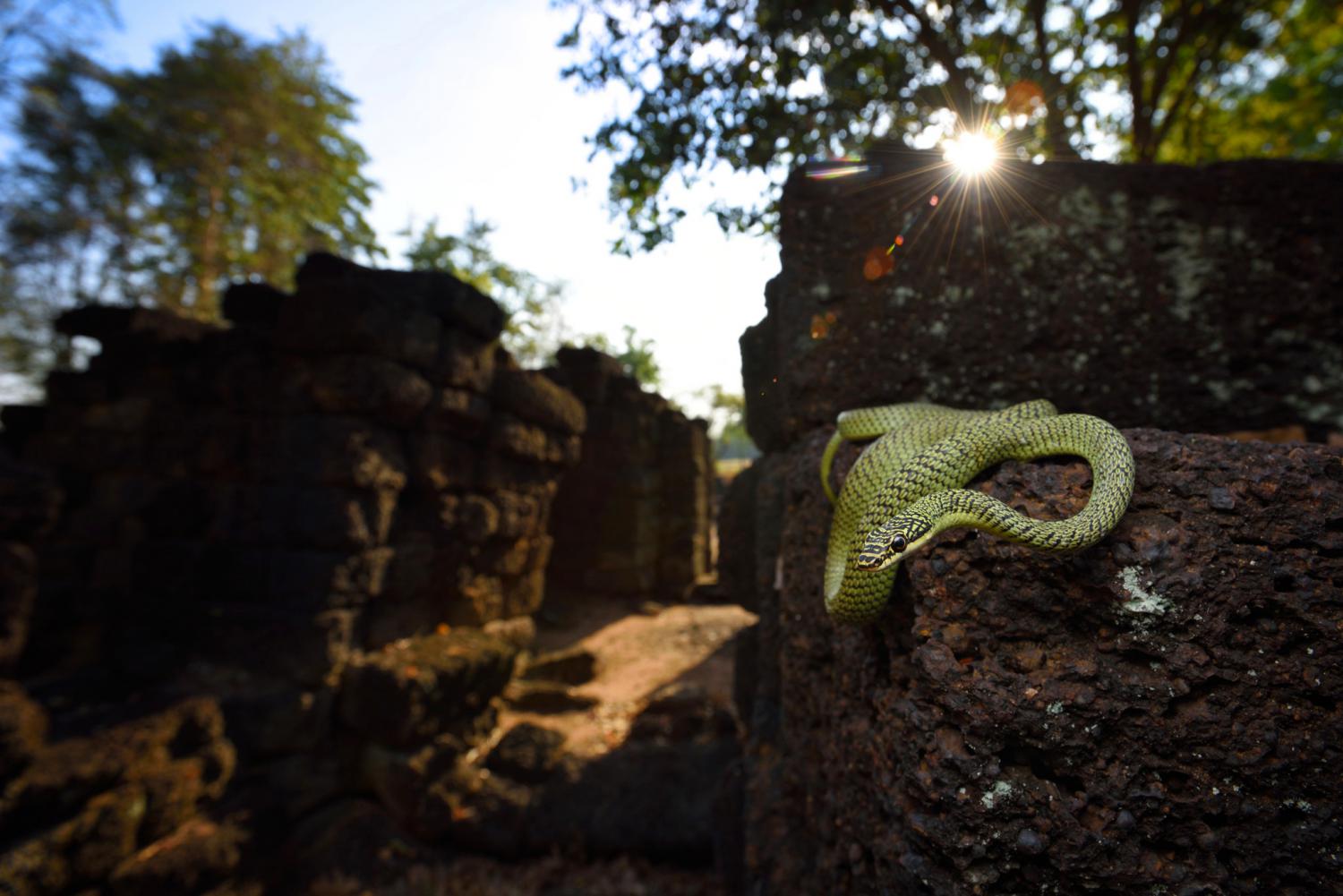Species of Thailand
Golden tree snake
Chrysopelea ornata
(George Shaw, 1802)
In Thai: งูเขียวพระอินทร์, ngu khiao phra in
Chrysopelea ornata is a mildly venomous opisthoglyphous (rear-fanged) colubrid snake found in both South and Southeast Asia. Along with the other species in the Chrysopelea genus, the golden tree snake is very unusual, as it is capable of a type of gliding “flight” (more of a controlled “throwing” or “falling”)—mainly utilised during the pursuit of prey animals—from tree-to-tree. This action is also used to great effect for the snake to flee its own potential predators (such as birds or other reptiles). Currently, three subspecies are recognised. The snake's striking looks, and potential for gliding, have made it a coveted choice for captivity.
Description
Chrysopelea ornata is usually green in color, with black cross-hatching and yellow or gold colored accents. The body, though slender, is far less so than in other tree snakes. It has a flattened head with constricted neck, a blunt nose and large eyes with round pupils.
The lateral, sharp and pronounced keeled condition of the ventrals in association with the normal, not enlarged, vertebral row of scales distinguish this snake.
This snake ranges from 11.5 to 130 cm long. Maturity is reached at about 1 m in length. The tail is about one-fourth of the total length.
Chrysopelea ornata has two major colour forms, and their descriptions are given below:
- In Sri Lanka and the southern extent of its Indian range, the snake is primarily greenish yellow or pale green. Each scale has a black mesial streak or spot, and is more or less edged with black. The snake also has dark crossbars at intervals. A series of large, flower-shaped, reddish or orange vertebral spots may be present or absent. Ventrals greenish, outside the keel edged with black or spotted. Head black with yellow crossbars and spots. The flower-shaped spots are more common in Sri Lanka than in south India.
- The second color variety which is more common in Southeast Asia lacks the reddish vertebral spots, and has less prominent black crossbars. But all varieties can be found throughout its distribution area.
Venom
This species is considered mildly venomous, as it is rear-fanged (opisthoglyphous). This is an adaptive feature present in many genera of snakes, such as the hognose and mangrove snakes (among others), in which two small fangs are situated closer to the rear of the mouth (on the upper jaw), as opposed to frontal-fanged (solenoglyphous) venomous snakes, which possess retractable, long, sharp fangs at the front of the mouth (which deliver quick and lethal doses of venom). Opisthoglyphy is typically indicative of an animal that consumes reptiles and/or amphibians, as it is thought that the placement of the teeth in the back of the mouth aids the snake in wrangling and controlling wriggly, slippery lizards, frogs, toads, etc. In order for the venom to be administered and the prey subdued, it must first be “chewed” into the prey, as the rear fangs are not placed immediately at the front of the mouth; by comparison, vipers and elapids (which are frontal-fanged) generally prefer avian, rodent or other mammalian prey, which they bite once before retreating, waiting for envenomation to kill the animal before consuming. The ease with which frontal-fanged snakes can deliver their deadly venom makes them medically significant and dangerous to humans and other animals; rear-fanged snakes, including the Chrysopelea species, are therefore not considered so dangerous to humans as to be of medical importance.
Common names
- English - golden tree snake, gliding snake, ornate flying snake, golden flying snake, gold and black tree snake, flying tree snake
- Hindi - kala jin.
- Sinhala - pol-mal-karawala, malsara.
- German - Gelbgrüne Schmuckbaumnatter, Gewöhnliche Schmuckbaumnatter.
- Bengali - কালনাগিনী (Kaalnagini), উড়ন্ত সাপ, উড়াল মহারাজ সাপ, সুন্দরী সাপ, কালসাপ, কালনাগ
- Konkani - Naneto
- Nepali Name - Seerise
- Thai Name: งูเขียวดอกหมาก (Ngoo kee-ow dork maak)
- Khmer Name: ពស់តុកកែ (Pous Tok Kae)
- Malayalam: nagathan pambu(നാഗത്താൻ പാമ്പ് )
Geographic range
India (North Bengal), Bangladesh, Sri Lanka, Nepal, Myanmar, Thailand, Western Malaysia, Laos, Cambodia, Vietnam, China (Hong Kong, Hainan, Yunnan), and Singapore (introduced).
In India Chrysopelea ornata ranges from the Western Ghats, up to the Dangs, Katernia Ghat in Uttar Pradesh, North Bihar, northern West Bengal eastwards to Arunachal Pradesh. It is also found in the forests of the Andaman islands.
Conservation
Not known to be endangered.
Subspecies
Three subspecies of C. ornata are recognized:
- C. o. ornata – southwest India
- C. o. ornatissima – north and east India, Nepal, Bangladesh and Southeast Asia
- C. o. sinhaleya – Sri Lanka.
Behaviour
C. ornata is diurnal and arboreal. The snake's gliding ability, while not as impressive as that of the paradise flying snake (C. paradisi), still makes it capable of moving from tree to tree with relative ease. These snakes are excellent climbers, being able move across even the smallest of branches and even straight up trees with few branches by using the edges of rough bark. They are frequently seen moving up a coconut palm, or up vertical rock faces in graceful curves, gripping the somewhat uneven surfaces with their scales. They tend to be nervous, fast-moving snakes, and attempt to flee if disturbed, but generally do not hesitate to bite if handled. They are mildly venomous, but the venom is not considered to be dangerous to humans. It is intended to assist in subduing fast-moving, arboreal prey.
C. ornata takes small arboreal prey, such as lizards, bats, and small rodents. It might also feed on bird eggs and insects. Also, it is reported to take snakes occasionally, and to avoid frogs, though frogs are also reported being eaten. The snake stalks or pursues the prey and seizes it by the neck, which is crushed in its strong jaws.
Flight
C. ornata, like others of its genus, glides or parachutes. This is presumably done to cover distances faster, to escape predators, to catch prey, or to move around in forests. Flying snakes usually parachute from tree to tree, but sometimes launch themselves from trees onto the ground. They have been known to cross as much as 100 m.
It does this by climbing up to a height, which it does easily by virtue of its keeled belly scales, and then launching itself into mid-air. The snake contracts its ventral surface inwards to form a U-shaped concave depression along the entire length of their bodies, holding the outer edges of the ventral scales rigid. This concave surface acts like a parachute, and increases air resistance, allowing the snake to glide forward with the thrust of its launch. The snake undulates through the air, in a swimming-like motion. It holds the tail rigidly upwards, and by twisting the tail from side to side, it attains balance. This motion allows it to propel forward, landing clumsily at the end of its flight.
Human habitats
C. ornata is a common snake and has adapted well to human habitats. In southern parts of Thailand, they are reported to hide in the thatch of the roofing material inside bungalows to prey on geckos and mice during the night. In these areas, one can almost be certain to be relatively close to a C. ornata most anywhere, perhaps hiding in the crown of the nearby coconut palm, under the roots of a tree, or even curled up in a potted plant. When hunting and pursuing fleeing prey, they have been reported to drop down out of the crown of coconut palms. Snakes are often indiscriminately killed, as many locals incorrectly assume all snakes are venomous. C. ornata is sometimes cooked for food.
Reproduction
Breeding habits are little known. The snake is oviparous and six to 12 elongated eggs are laid. Gravid females have been in May and June and hatchlings in June. In Bangkok, according to Smith, mating takes place in June. Hatchlings measure 114–152 mm (4 to 6 in) long, while the smallest gravid female recorded was 1, 093 mm (3 ft 7 in) long.
In captivity
In recent years, ornate flying snakes have become increasingly available in the exotic pet trade; many are exported from Vietnam and neighboring countries. Instances of captive breeding are virtually unknown. Due to the species' nervous temperament and difficulty to adjusting to captivity, they tend to make poor captives for all but the most experienced reptile keepers. Many imported specimens have heavy parasite loads, and the stress of captivity all too often leads to a quick death.
This article uses material from Wikipedia released under the Creative Commons Attribution-Share-Alike Licence 3.0. Eventual photos shown in this page may or may not be from Wikipedia, please see the license details for photos in photo by-lines.
Scientific classification
- Kingdom
- Animalia
- Phylum
- Chordata
- Subphylum
- Vertebrata
- Class
- Reptilia
- Order
- Squamata
- Suborder
- Serpentes
- Family
- Colubridae
- Genus
- Chrysopelea
- Species
- Chrysopelea ornata
Common names
- German:
- Gelbgrüne Schmuckbaumnatter
- Gewöhnliche Schmuckbaumnatter
- English:
- Golden tree snake
- Golden flying snake
- Indian flying snake
- Thai: งูเขียวพระอินทร์, ngu khiao phra in
Subspecies
Chrysopelea ornata ornata, George Shaw, 1802
Range: India, Nepal, Sri Lanka, Myanmar, Thailand, West Malaysia, Laos, Cambodia, Vietnam, China, Hong Kong, Philippines
Chrysopelea ornata ornatissima, Franz Werner, 1925
Range: Cambodia
Chrysopelea ornata sinhaleya, Paul E. Pieris Deraniyagala, 1945
Range: Sri Lanka
Conservation status

Least Concern (IUCN 3.1)
Photos
Please help us review our species pages if wrong photos are used or any other details in the page is wrong. We can be reached via our contact us page.
Range Map

- Ban Bueng District, Chonburi
- Ban Chang District, Rayong
- Ban Dan Lan Hoi District, Sukhothai
- Ban Dung District, Udon Thani
- Ban Khok District, Uttaradit
- Ban Khwao District, Chaiyaphum
- Ban Lat District, Phetchaburi
- Ban Na San District, Surat Thani
- Ban Phai District, Khon Kaen
- Ban Pho District, Chachoengsao
- Ban Phue District, Udon Thani
- Bang Kapi District, Bangkok
- Bang Khae District, Bangkok
- Bang Khla District, Chachoengsao
- Bang Khun Thian District, Bangkok
- Bang Krathum District, Phitsanulok
- Bang Kruai District, Nonthaburi
- Bang Lamung District, Chonburi
- Bang Pakong District, Chachoengsao
- Bang Phli District, Samut Prakan
- Bang Rak District, Bangkok
- Bang Sue District, Bangkok
- Bang Yai District, Nonthaburi
- Bangkok Province
- Bangkok Noi District, Bangkok
- Betong District, Yala
- Borabue District, Maha Sarakham
- Cha-Am District, Phetchaburi
- Chat Trakan District, Phitsanulok
- Doi Saket District, Chiang Mai
- Doi Suthep - Pui National Park
- Doi Tao District, Chiang Mai
- Erawan National Park
- Hang Dong District, Chiang Mai
- Hat Yai District, Songkhla
- Hua Hin District, Prachuap Khiri Khan
- Huai Kha Khaeng Wildlife Sanctuary
- Huai Thap Than District, Sisaket
- Huai Yang Waterfall National Park
- Huai Yot District, Trang
- Kaeng Krachan District, Phetchaburi
- Kaeng Krachan National Park
- Kaeng Krung National Park
- Kantang District, Trang
- Kantharalak District, Sisaket
- Kathu District, Phuket
- Kham Thale So District, Nakhon Ratchasima
- Khao Ang Rue Nai Wildlife Sanctuary
- Khao Banthat Wildlife Sanctuary
- Khao Laem Ya - Mu Ko Samet National Park
- Khao Sok National Park
- Khao Yai Da
- Khao Yai National Park
- Khiri Rat Nikhom District, Surat Thani
- Khlong Lan District, Kamphaeng Phet
- Khlong Thom District, Krabi
- Khlong Yai District, Trat
- Khon Buri District, Nakhon Ratchasima
- Khuan Don District, Satun
- Khun Yuam District, Mae Hong Son
- Klaeng District, Rayong
- Ko Chang District, Trat
- Ko Chang National Park
- Ko Kha District, Lampang
- Ko Kut District, Trat
- Ko Lanta District, Krabi
- Ko Lanta National Park
- Ko Pha-ngan District, Surat Thani
- Ko Samui District, Surat Thani
- Ko Tao
- Ko Yao District, Phang Nga
- Kuchinarai District, Kalasin
- Kui Buri National Park
- Lak Si District, Bangkok
- Lam Thamenchai District, Nakhon Ratchasima
- Laplae District, Uttaradit
- Lat Phrao District, Bangkok
- Mae Ai District, Chiang Mai
- Mae Sot District, Tak
- Makham District, Chanthaburi
- Min Buri District, Bangkok
- Mueang Amnat Charoen District, Amnat Charoen
- Mueang Bueng Kan District, Bueng Kan
- Mueang Buriram District, Buriram
- Mueang Chanthaburi District, Chanthaburi
- Mueang Chiang Mai District, Chiang Mai
- Mueang Chiang Rai District, Chiang Rai
- Mueang Chonburi District, Chonburi
- Mueang Chumphon District, Chumphon
- Mueang Kanchanaburi District, Kanchanaburi
- Mueang Khon Kaen District, Khon Kaen
- Mueang Krabi District, Krabi
- Mueang Lamphun District, Lamphun
- Mueang Mae Hong Son District, Mae Hong Son
- Mueang Nakhon Ratchasima District, Nakhon Ratchasima
- Mueang Nakhon Si Thammarat District, Nakhon Si Thammarat
- Mueang Nan District, Nan
- Mueang Nong Khai District, Nong Khai
- Mueang Nongbua Lamphu District, Nong Bua Lamphu
- Mueang Nonthaburi District, Nonthaburi
- Mueang Pathum Thani District, Pathum Thani
- Mueang Pattani District, Pattani
- Mueang Phang Nga District, Phang Nga
- Mueang Phatthalung District, Phatthalung
- Mueang Phayao District, Phayao
- Mueang Phetchabun District, Phetchabun
- Mueang Phetchaburi District, Phetchaburi
- Mueang Phichit District, Phichit
- Mueang Phuket District, Phuket
- Mueang Prachuap Khiri Khan District, Prachuap Khiri Khan
- Mueang Ratchaburi District, Ratchaburi
- Mueang Rayong District, Rayong
- Mueang Roi Et District, Roi Et
- Mueang Sakon Nakhon District, Sakon Nakhon
- Mueang Samut Prakan District, Samut Prakan
- Mueang Samut Sakhon District, Samut Sakhon
- Mueang Satun District, Satun
- Mueang Sisaket District, Sisaket
- Mueang Songkhla District, Songkhla
- Mueang Sukhothai District, Sukhothai
- Mueang Surat Thani District, Surat Thani
- Mueang Trang District, Trang
- Mueang Udon Thani District, Udon Thani
- Mueang Uthai Thani District, Uthai Thani
- Na Mon District, Kalasin
- Na Yai Am District, Chanthaburi
- Na Yong District, Trang
- Nam Nao National Park
- Nang Rong District, Buriram
- Non Sung District, Nakhon Ratchasima
- Non Thai District, Nakhon Ratchasima
- Nong Bua Daeng District, Chaiyaphum
- Nong Chok District, Bangkok
- Nong Han District, Udon Thani
- Nong Khaem District, Bangkok
- Nong Phai District, Phetchabun
- Nong Wua So District, Udon Thani
- Nuea Khlong District, Krabi
- Op Luang National Park
- Pai District, Mae Hong Son
- Pak Chong District, Nakhon Ratchasima
- Pak Thong Chai District, Nakhon Ratchasima
- Panare District, Pattani
- Pang Mapha District, Mae Hong Son
- Pathio District, Chumphon
- Pathum Wan District, Bangkok
- Phak Hai District, Phra Nakhon Si Ayutthaya
- Phan District, Chiang Rai
- Phang Khon District, Sakon Nakhon
- Phanom District, Surat Thani
- Phasi Charoen District, Bangkok
- Phi Phi Islands
- Phibun Mangsahan District, Ubon Ratchathani
- Phimai District, Nakhon Ratchasima
- Pho Si Suwan District, Sisaket
- Photharam District, Ratchaburi
- Phra Nakhon Si Ayutthaya District, Phra Nakhon Si Ayutthaya
- Phra Pradaeng District, Samut Prakan
- Phra Samut Chedi District, Samut Prakan
- Phra Thong Kham District, Nakhon Ratchasima
- Phra Yuen District, Khon Kaen
- Phu Kradueng National Park
- Phu Langka National Park
- Phu Luang Wildlife Sanctuary
- Phu Pha Man District, Khon Kaen
- Phuket Province
- Phutthamonthon District, Nakhon Pathom
- Prachantakham District, Prachinburi
- Prakhon Chai District, Buriram
- Ratchathewi District, Bangkok
- Rattanawapi District, Nong Khai
- Rattaphum District, Songkhla
- Ron Phibun District, Nakhon Si Thammarat
- Sai Yok District, Kanchanaburi
- Sam Phran District, Nakhon Pathom
- Sam Roi Yot District, Prachuap Khiri Khan
- Samphanthawong District, Bangkok
- San Kamphaeng District, Chiang Mai
- San Sai District, Chiang Mai
- Saphan Sung District, Bangkok
- Sattahip District, Chonburi
- Sawankhalok District, Sukhothai
- Si Chomphu District, Khon Kaen
- Si Maha Phot District, Prachinburi
- Si Racha District, Chonburi
- Si Sawat District, Kanchanaburi
- Sikao District, Trang
- Sikhoraphum District, Surin
- Soem Ngam District, Lampang
- Somdet District, Kalasin
- Sri Nakarin Dam National Park
- Su-ngai Padi District, Narathiwat
- Suan Luang District, Bangkok
- Takua Pa District, Phang Nga
- Tan Sum District, Ubon Ratchathani
- Tha Bo District, Nong Khai
- Tha Chang District, Sing Buri
- Tha Li District, Loei
- Tha Luang District, Lopburi
- Tha Mai District, Chanthaburi
- Tha Maka District, Kanchanaburi
- Tha Sala District, Nakhon Si Thammarat
- Tha Takiap District, Chachoengsao
- Tha Yang District, Phetchaburi
- Thai Mueang District, Phang Nga
- Thalang District, Phuket
- Thale Ban National Park
- Thap Sakae District, Prachuap Khiri Khan
- That Phanom District, Nakhon Phanom
- Thong Pha Phum District, Kanchanaburi
- Thung Khru District, Bangkok
- Thung Salaeng Luang National Park
- Thung Yai Naresuan Wildlife Sanctuary
- Ton Nga-Chang Wildlife Sanctuary
- Uthumphon Phisai District, Sisaket
- Wang Nam Khiao District, Nakhon Ratchasima
- Watthana Nakhon District, Sa Kaeo
- Wichian Buri District, Phetchabun
- Wihan Daeng District, Saraburi


